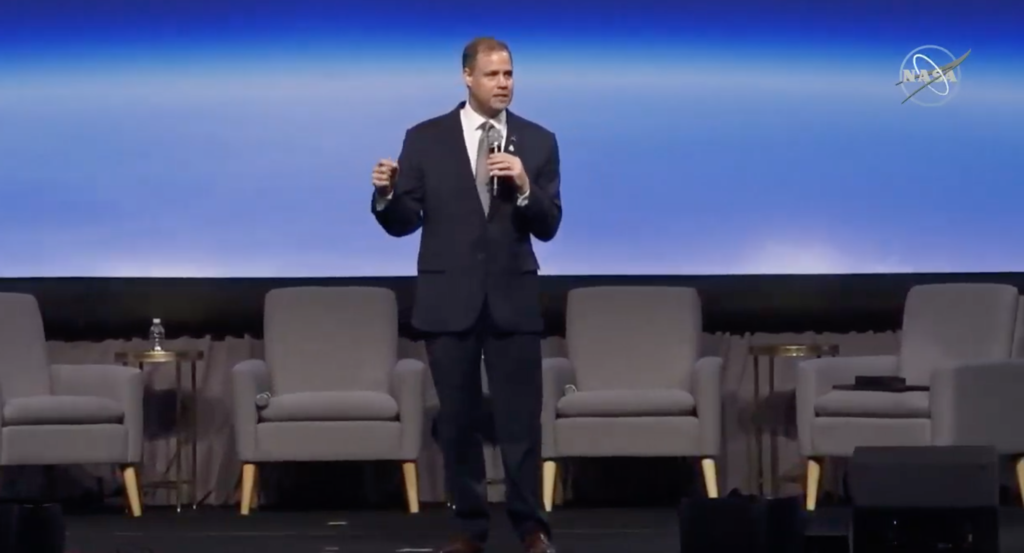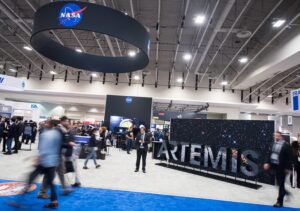“We are on the cusp of once again launching American astronauts on rockets from American soil for the first time since the retirement of the shuttle in 2011. We now need to return to that activity with our international partners as we work to commercialize Low Earth Orbit (LEO). We are looking for breakthroughs that will transform how we live on Earth, and when those breakthroughs occur, capital will flow into what will be commercially habitation capability and commercial space stations in LEO. So how do we do that? One of our lines of effort is industrialized biomedicine,” announced NASA Administrator Jim Bridenstine on Friday during a public update on the agency’s Artemis program and the critical role international partnerships have in returning astronauts to the Moon and going on to Mars.
The discussion, From the Moon to Mars: NASA’s Artemis Program, took place during Public Day at the 70th International Astronautical Conference (IAC) in Washington DC. It’s the one day when regular people have the opportunity to go to the IAC and hear updates on NASA activity, including major discoveries and future missions. IAC brings together space agencies, astronauts and scientists from all over the world to discuss the latest discoveries, missions, and ideas for space exploration.
 Bridenstine is very focused on the next steps for humanity in space. During his address, which was broadcast live on NASA’s site, he highlighted the importance of learning about biomedicine in space and emphasized the usefulness of going to space sustainably, by learning to utilize the resources available on-site, as part of the human experience in orbit, which will allow us to live and work for long periods of time. Also suggesting that ultimately the technologies and capabilities that we develop on the ISS, LEO and the Moon, will be replicable on Mars.
Bridenstine is very focused on the next steps for humanity in space. During his address, which was broadcast live on NASA’s site, he highlighted the importance of learning about biomedicine in space and emphasized the usefulness of going to space sustainably, by learning to utilize the resources available on-site, as part of the human experience in orbit, which will allow us to live and work for long periods of time. Also suggesting that ultimately the technologies and capabilities that we develop on the ISS, LEO and the Moon, will be replicable on Mars.
“As we move forward, there’s a lot that needs to be done, but right now we are using the ISS to 3D print human tissue and eventually human organs using adult stem cells, with the purpose of transforming our lives here on Earth,” went on Bridenstine.

NASA Administrator Jim Bridenstine at the 70th International Astronautical Congress (Photo Credit: NASA/Bill Ingalls)
“At the moment we are working on creating artificial retinas in orbit. These are the things that you cannot do here on Earth because of the way materials are layered, but you can do it in the microgravity of space using the ISS. Imagine a box, that fits in the palm of your hand, and then up it goes to space with materials inside. But when that box comes back to Earth, we open it up to find a thousand artificial retinas. These retinas could help people who have macular degeneration and are at risk of losing their eyesight. I’m not saying that I know this is going to happen, all I’m conveying is that we are working on it, day in and day out,” he suggested.
Using the ISS to generate breakthroughs is just the first step, which, according to Bridenstine, will result in capital formation so that we can have a future with multiple space stations funded by the commercial industry. This is the way NASA can have a continuous presence in LEO.
“NASA wants to be one customer of many in a very robust commercial marketplace in LEO. Just like what we are doing with the commercial resupply of the ISS, we want to have numerous providers competing against each other on cost and innovation. Because that is how we drive down costs and increase access.”
Commercial resupply, commercial crew, and eventually commercial habitation are part of what the NASA administrator considers key to a successful commercial operation in LEO. A retired navy aviator and politician, Bridenstine repeated once and again that the US is going to space with international and commercial partners, claiming that, to see habitation in LEO that is commercial in nature, “we need industrial biomedicine and advanced materials to be successful.”
He suggested that “when the Apolo mission ended, we had an eight-year gap before the shuttles began going to space, and after the shuttles ended, we receded into another eight-year gap. So we want to make sure that we don’t have a gap during our presence in LEO. We need to return to the Moon, except that when we do it this time around, we are not going back to the moon, we are going forward to the Moon.”
During the last few years, NASA has been a great enabler for scientists, commercial and international partners to generate an open architecture in space, where competitiveness drives the creative imagination, and, as Bridenstine suggested, brings down costs. Many bioprinting and 3D printing endeavors reached the ISS, traveling as payloads on commercial rockets. Just two weeks ago, NASA and Made In Space talked about the upcoming launch of the Made In Space Recycler facility to test systems for reprocessing plastic into 3D printing filament to create new items in microgravity. In late July the NASA Bio Fabrication Facility left on a resupply mission to the ISS where astronauts at the ISS National Lab will grow heart tissue. Dozens of companies are becoming more and more interested in proposing ideas that could help solve many of the challenges that humans will encounter during space exploration, and the American agency is certainly opening up the door to generate a competitive environment that will develop into a commercial future for everyone.
Visitors to IAC also learned from Bridenstine about some of the future missions for NASA, including the new VIPER lunar rover that will map water ice on the Moon; the reusable command module Gateway, which will orbit the Moon and support human missions to the lunar surface for 15 years; and the OSIRIS-REx spacecraft, currently traveling to a near-Earth asteroid called Bennu to bring a small sample back for study. All of these missions will provide much-needed research for crew missions to survive in space.
The head of NASA highlighted the impact the agency has all around the world “to inspire children and shape their imaginations, not just towards exploration, science and discovery,” but also “towards the US and how the country is building a coalition of nations.” According to Bridenstine, NASA receives less than one half of one percent of America’s federal budget, yet the groundwork it has laid to take the plunge into space is huge, even increasing the probability of discovering life on another planet.
3D printing is certainly set to play a crucial role in deep space exploration and it will be a critical technology for long-term duration flights, avoiding spacecraft to carry such large payloads, making the trip entirely more sustainable.
“We’re going to the Moon to learn how to live and work for long periods of time, because ultimately when we go to Mars, we’re going to have to be there for a long time. Earth and Mars are on the same side of the Sun once every 26 months, that means that when our astronauts go, they have to be ready to stay. The moon is the proving ground, but Mars is the destination.”
“We went to the Moon in the 1960’s with the Apolo program, but it so happens that in Greek mythology, Apolo has a twin sister, Artemis, and she is the goddess of the Moon. So, this time, we go under the name Artemis, this time we’ll stay and have a very diverse, highly qualified core that includes women. This is our generation: we are the Artemis generation, we need to own it, take control of it and make it happen.”
The NASA exhibit at IAC also featured a Moon rock, Mars meteorite, a 1:10 scale model of the Mars 2020 rover, and a model of the Gateway. You can stay involved on social media using the hashtags #JoinArtemis and #IAC2019.
Subscribe to Our Email Newsletter
Stay up-to-date on all the latest news from the 3D printing industry and receive information and offers from third party vendors.
Print Services
Upload your 3D Models and get them printed quickly and efficiently.
You May Also Like
3D Printing News Briefs, July 2, 2025: Copper Alloys, Defense Manufacturing, & More
We’re starting off with metals in today’s 3D Printing News Briefs, as Farsoon has unveiled a large-scale AM solution for copper alloys, and Meltio used its wire-laser metal solution to...
3DPOD 260: John Hart on VulcanForms, MIT, Desktop Metal and More
John Hart is a Professor at MIT; he´s also the director of the Laboratory for Manufacturing and Productivity as well as the director of the Center for Advanced Production Technologies....
3D Printing News Briefs, June 28, 2025: Defense Accelerator, Surgical Models, & More
In this weekend’s 3D Printing News Briefs, 3YOURMIND was selected to join an EU Defense Accelerator, and PTC has announced model-based definition (MBD) capabilities within Onshape. Finally, a study out...
EOS in India: AM’s Rising Star
EOS is doubling down on India. With a growing base of aerospace startups, new government policies, and a massive engineering workforce, India is quickly becoming one of the most important...




































